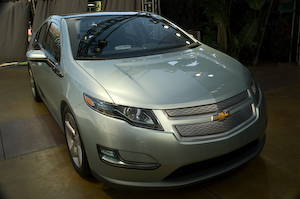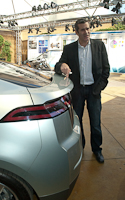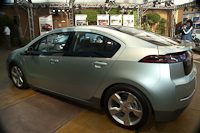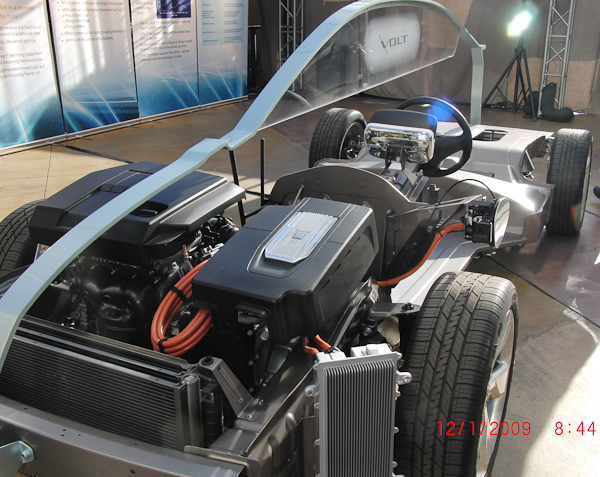![]()
 |
Chevrolet Volt - Impressions
|
| Disclaimer: Our apologies for not being complete here... we're not automotive experts or professional car drivers, so we cannot comment on subtle details such as high-speed cornering handling. (Nor do we care, short of having the car roll over). We're also not that concerned with styling. We're primarily interested in the specifics of the EV implementation from the consumer's viewpoint. During the short time we had to see the car, we forgot to note numerous small points. We hope to correct that by getting more information from the Chevrolet team and even getting another test drive further down the line. |
 Our test-drive day started in the morning in a downtown Los Angeles restaurant with a walk-around and presentation of the Volt itself by the Chevy team (primarily Tony Posawatz, Volt Line Director and Bob Boniface, Design Director).
Our test-drive day started in the morning in a downtown Los Angeles restaurant with a walk-around and presentation of the Volt itself by the Chevy team (primarily Tony Posawatz, Volt Line Director and Bob Boniface, Design Director).
We both found this very interesting as they went into the the behind-the-scenes reasoning for design decisions such as the tweaking of the shape of the car for aerodynamic efficiency. It was clear that aerodynamics were important in the design just from the smooth shape of the car from front to back, and the way the windshield wipers are tucked away under the back end of the hood. But like the dimples of a golf ball, even slight indentations at the rear of the car have aerodynamic significance. The effort put into aerodynamic detailing of the car made us especially happy after seeing the disappointing range of both the RAV4 EV and Mini E when driving at freeway speeds.
 Despite the emphasis on aerodynamics, the car still looks like a "normal" modern car. We're as eager as anyone for onlookers to notice the fact that we're driving an EV instead of a gas car, but we hate to drive around and stick out like a sore thumb. Too many of the "cute" neighborhood EV's look out of place in traffic and resemble an blob of extruded toothpaste.
Despite the emphasis on aerodynamics, the car still looks like a "normal" modern car. We're as eager as anyone for onlookers to notice the fact that we're driving an EV instead of a gas car, but we hate to drive around and stick out like a sore thumb. Too many of the "cute" neighborhood EV's look out of place in traffic and resemble an blob of extruded toothpaste.
We never even got used to the EV1's back end shape and covered rear wheels, though intellectually, we know they were important to making that car super efficient aerodynamically. The Volt does not get to the low drag coefficient of the EV1, but we were told it is aerodynamically the best car ever created by Chevrolet.
Also on display was a similar-looking gasoline vehicle (Chevy Cruze) so they are probably utilizing common parts to take advantage of volume production prices for at least some of the Volt parts and perhaps the Cruze also benefits from the shape in getting to its estimate of 40mpg.
Another interesting display was a cut-away display of the Volt, which made several points clear:
- The charging port is at the left front, near the driver's door, while the gas filler is at the right rear. The charging port takes either 120V or 240V AC. In theory, no special charging box is necessary but building safety codes will probably require a special connection box for 240V connections.
- The power electronics box is mounted side-by-side with the gas engine-generator. This arrangement was chosen partly because the behavior of the car in a crash is well known from experience with front-engine gasoline cars. The electronics are on the driver's side of the compartment, while the gas engine is on the passenger's side.
- The batteries are laid out in a "T" configuration (as in the EV1).
- The gas tank is behind the battery pack.
- There are very large heat exchanger panels at the front. Some of this is due the the fact that the battery pack temperature is carefully controlled with liquid cooling.
Unlike the EV1, the Volt is designed to keep the battery charge within a narrower range of charge state. Only about 1/2 of the pack's actual charge capacity is used in order to maximize the life of the battery pack. In conjunction with careful temperature management, the pack is expected to last and be warrantied for 8-10 years (up to 150,000 miles), if I recall correctly.
